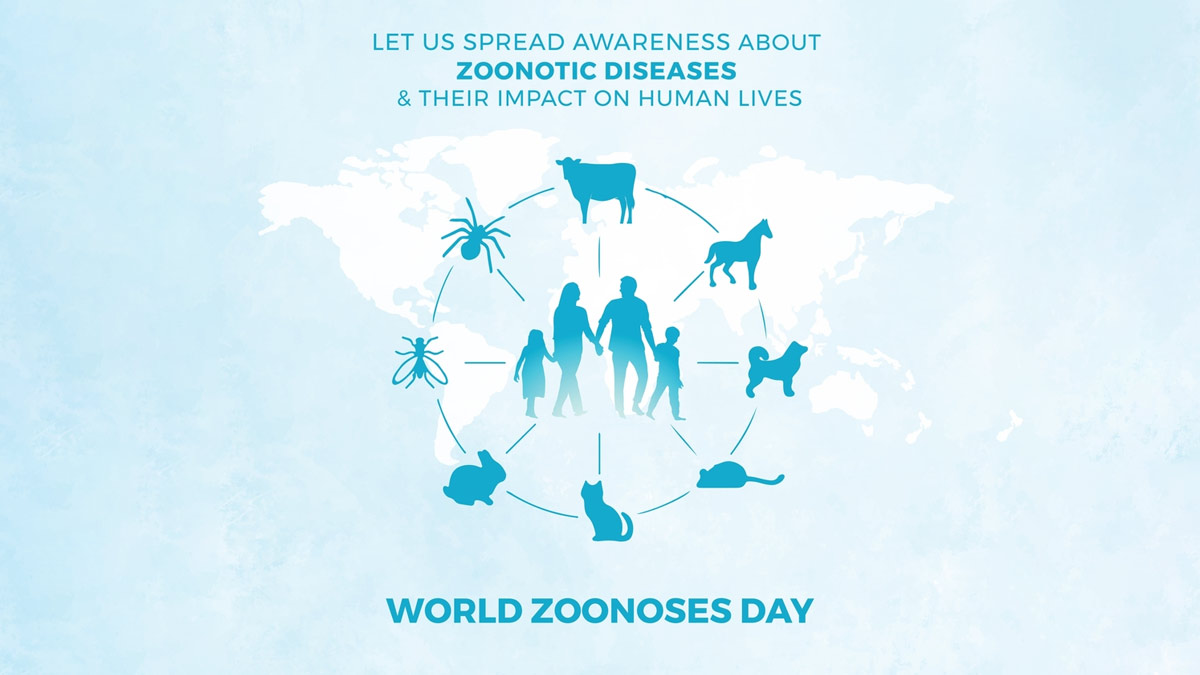
World Zoonoses Day, observed on July 6, marks an opportunity to raise awareness about zoonotic diseases—those that can be transmitted from animals to humans. As the world grapples with emerging health threats, understanding zoonotic diseases and their prevention becomes crucial. Here are ten common zoonotic diseases and ways to prevent them.
Table of Content:-
1. Rabies
As per studies, rabies is a viral disease affecting the central nervous system. It is usually transmitted through the bite of an infected animal, often dogs.

Prevention: Vaccinating pets against rabies, avoiding contact with wild animals, and seeking immediate medical attention if bitten are key prevention measures.
2. Lyme Disease
Caused by the bacterium Borrelia burgdorferi, Lyme disease is transmitted through the bite of infected black-legged ticks.
Prevention: Using insect repellent, wearing long sleeves and pants in wooded areas, and checking for ticks after outdoor activities can help prevent Lyme disease.
Also read: What Is Lyme Disease? Here Are Its Causes, Symptoms, Prevention And Treatment
3. Salmonellosis
Research indicates that salmonellosis is an infection caused by Salmonella bacteria, often found in contaminated food or water.
Prevention: Properly cooking food, practising good hand hygiene, and avoiding raw or undercooked eggs and meat are essential to prevent salmonellosis.
4. West Nile Virus
This virus is primarily spread by mosquitoes that have bitten infected birds. It can cause neurological diseases in humans.
Prevention: Using mosquito repellent, wearing protective clothing, and eliminating standing water where mosquitoes breed can reduce the risk of West Nile virus.

5. Hantavirus
Hantavirus is transmitted through contact with rodent urine, droppings, or saliva. It can cause severe respiratory illness.
Prevention: Keeping homes and workplaces rodent-free, sealing potential entry points, and using protective gear when cleaning rodent-infested areas are crucial preventive measures.
6. Avian Influenza
Also known as bird flu, avian influenza is caused by influenza viruses that primarily affect birds but can sometimes infect humans.
Prevention: Avoiding contact with infected birds, proper handling and cooking of poultry, and monitoring for outbreaks are important for prevention.
Also read: How Does Bird Flu Affect Humans? Know Everything About H5N1 Avian Influenza
7. Brucellosis
Brucellosis is caused by Brucella bacteria. The World Health Organization states that this bacteria mainly infects cattle, swine, goats, sheep and dogs. “Humans generally acquire the disease through direct contact with infected animals, by eating or drinking contaminated animal products or by inhaling airborne agents,” it stated.
Prevention: Using protective clothing when handling animals, consuming pasteurised dairy products, and vaccinating livestock are key preventive steps.

8. Leptospirosis
Leptospirosis is caused by Leptospira bacteria, often found in water contaminated by animal urine. According to the Centre for Disease Control and Prevention, Without treatment, leptospirosis in people can lead to kidney damage, meningitis (inflammation of the membrane around the brain and spinal cord), liver failure, trouble breathing, and even death.
Prevention: Avoiding swimming in potentially contaminated water, wearing protective gear during outdoor activities, and maintaining good hygiene can prevent leptospirosis.
9. Ebola Virus Disease
Overview: Ebola is a severe viral illness transmitted through contact with blood or bodily fluids of infected animals or humans.

Prevention: Avoiding contact with infected individuals and animals, practising good hygiene, and following public health guidelines during outbreaks are essential.
10. Plague
Overview: Caused by Yersinia pestis bacteria, plague is typically spread by fleas that have fed on infected rodents.
Prevention: Reducing rodent habitats, using flea control products on pets, and maintaining good sanitation can help prevent plague.
General Preventive Measures for Zoonotic Diseases
Hygiene and Sanitation: Regular handwashing, especially after handling animals or animal products, and maintaining clean living environments can reduce the risk of zoonotic diseases.
Vaccination: Vaccinating pets and livestock against common zoonotic diseases protects both animals and humans.
Food Safety: Properly cooking food, avoiding raw or undercooked animal products, and practising good food hygiene are crucial.
Vector Control: Using insect repellent, wearing protective clothing, and eliminating standing water can help control vectors like mosquitoes and ticks.
Public Awareness: Educating communities about zoonotic diseases and their prevention can foster a proactive approach to health.
Conclusion
World Zoonoses Day reminds us of the interconnectedness of human, animal, and environmental health. By understanding common zoonotic diseases and adopting preventive measures, we can safeguard our health and build a healthier world. Through vigilance and cooperation, we can mitigate the impact of these diseases and promote a safer, healthier future for all.
Also watch this video
How we keep this article up to date:
We work with experts and keep a close eye on the latest in health and wellness. Whenever there is a new research or helpful information, we update our articles with accurate and useful advice.
Current Version